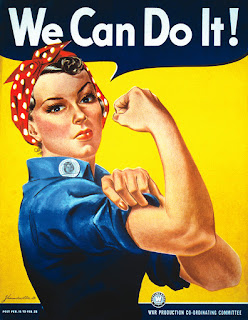Should We Remember ‘Rosie The Riveter’?
Content Analysis and Iconography
‘Rosie the Riveter’ is an image of a white woman wearing working man’s uniform with rolled up sleeves staring directly into the camera under the speech bubble “We Can Do It!”. This body language and costuming is used to symbolise masculinity and male power in women. The flexed arm alludes to upper body strength, again communicating the message that women are equal to or as strong and capable as men. The blue collared shirt communicates the message of the poster that women are being recruited for work. The words “We Can Do It!” are capitalised, bold, white on a dark background followed by an explanation mark. The text works as an extension of the visual meaning of the poster, by further creating an audience-poster connection, increasing feelings of empowerment hence, encouraging female workplace involvement. The colours in the image: yellow background contrasted by blue uniform and text “We Can Do It!”, allow for juxtaposition of the actor and messages in the image. These bold and direct signs in the poster demand female audience attention. By studying how these signs and cultural symbols work together to create an image, one can see how effective imagery can be in social movements.
Contextual analysis
The original poster - illustrated by a man, J. Howard Miller in 1944 (Catrina, 1995) - was not initially intended as a symbol for women’s liberation. It was used as a propaganda tool for the War Advertising Council (WAC) to hire women as replacements for male workers whom have gone to war. The poster was disseminated all over cities on magazines and newspapers and used in advertising campaigns to hire women and to sell products (Catrina, 1995). The reception of this poster was astounding; thousands of women joined the workforce which resulted in a permanent increase in female employment till this day (Bellou & Cardia, 2016). But controversy surrounding ‘Rosie the Riveter’ leaves feminist scholars debating if Rosie should be remembered as a symbol of feminism. Firstly, women whom were hired during the war were paid half as much as men were (Catrina, 1995) and when men returned to work after the war, the women were fired with minimal compensation (Catrina, 1995).
Rosie’s character – a white, young, seemingly-abled and average sized woman – is often critiqued as portraying and celebrating a white brand of feminism. Kimble & Olson (2006) critique the poster as visual rhetoric for the brand of white feminism. They argue the illustrators used a white, attractive female character to capture audience attention, presumed (preferably) white, although, many of the women whom seeked work at the time were migrants and people of colour. By featuring white women for the name and face of feminism, this deflected attention from racial minority women further disempowering those who experienced both gendered and racial layers of marginalisation (Kimble & Olson, 2006).
x
Contemporary analysis
Today, ‘Rosie the Riveter’ is still used as a symbol of feminism in schools and in culture. Celebrities such as Beyoncé, Demi Lovato, P!nk, Kendall Jenner and Patina Miller [4] have all recreated images of themselves dressed as ‘Rosie the Riveter’. This has critics and academics debating the nature, purpose and the effects of ‘celebrity feminism’. Social activist scholars criticise this as a commercialisation of feminism which the capitalist elite use for their own economic gain, with little regard of negative effects if the wrong messages are put forth. But, most can agree that having powerful social influencers – diverse in ethnicity, gender, age and ability – can only add visibility, inclusiveness and strength to the social movement.
By: Patricia Chaar
References
Bellou, A., & Cardia, E. (2016). Occupations after WWII: The legacy of Rosie the Riveter. Explorations in Economic History. 62, 124-142.
Catrina, E. (1995). Rosie the Riveter: Fashion and the factory. State University of New York. ProQuest Dissertations Publishing.
Doerr, N., & Milman, N. (2014). “Working with Images” in Donatella ella Porta (Ed), Methodological Practices in Social Movement Research, Oxford Scholarship Online.





Comments
Post a Comment